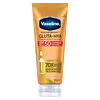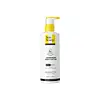What's inside
What's inside
 Key Ingredients
Key Ingredients

 Benefits
Benefits

 Concerns
Concerns

 Ingredients Side-by-side
Ingredients Side-by-side

Water
Skin ConditioningEthylhexyl Methoxycinnamate
UV AbsorberGlycerin
HumectantNiacinamide
SmoothingButyl Methoxydibenzoylmethane
UV AbsorberGlutathione
Sodium Hyaluronate
HumectantRetinyl Palmitate
Skin ConditioningHelianthus Annuus Seed Oil
EmollientGlycine
BufferingCystine
MaskingSodium PCA
HumectantPetrolatum
EmollientTriethanolamine
BufferingPhenoxyethanol
PreservativeDimethicone
EmollientCyclopentasiloxane
EmollientAcrylates/C10-30 Alkyl Acrylate Crosspolymer
Emulsion StabilisingParfum
MaskingMethylparaben
PreservativePropylparaben
PreservativeStyrene/Acrylates Copolymer
Disodium EDTA
Coco-Glucoside
CleansingBHT
AntioxidantBenzoic Acid
MaskingCitric Acid
BufferingPotassium Hydroxide
BufferingPotassium Carbonate
BufferingTocopherol
AntioxidantPotassium Chloride
Iron Oxides
Water, Ethylhexyl Methoxycinnamate, Glycerin, Niacinamide, Butyl Methoxydibenzoylmethane, Glutathione, Sodium Hyaluronate, Retinyl Palmitate, Helianthus Annuus Seed Oil, Glycine, Cystine, Sodium PCA, Petrolatum, Triethanolamine, Phenoxyethanol, Dimethicone, Cyclopentasiloxane, Acrylates/C10-30 Alkyl Acrylate Crosspolymer, Parfum, Methylparaben, Propylparaben, Styrene/Acrylates Copolymer, Disodium EDTA, Coco-Glucoside, BHT, Benzoic Acid, Citric Acid, Potassium Hydroxide, Potassium Carbonate, Tocopherol, Potassium Chloride, Iron Oxides
Water
Skin ConditioningOctocrylene
UV AbsorberNiacinamide
SmoothingEthylhexyl Salicylate
UV AbsorberButyl Methoxydibenzoylmethane
UV AbsorberTrehalose
HumectantMethylene Bis-Benzotriazolyl Tetramethylbutylphenol
UV FilterSodium Acrylate/Sodium Acryloyldimethyl Taurate Copolymer
Emulsion StabilisingC15-19 Alkane
SolventPEG-40 Hydrogenated Castor Oil
EmulsifyingPolyacrylate Crosspolymer-6
Emulsion StabilisingDecyl Glucoside
CleansingAvena Sativa Kernel Extract
AbrasiveOryza Sativa Bran Water
MaskingAloe Barbadensis Extract
Skin ConditioningSodium Polyacrylate
AbsorbentLauryl Glucoside
CleansingPropylene Glycol
HumectantXanthan Gum
EmulsifyingPropanediol
SolventPhenoxyethanol
PreservativeDimethicone
Emollient1,2-Hexanediol
Skin ConditioningHexyldecanol
EmollientHydroxypropyl Cyclodextrin
MaskingCeramide NP
Skin ConditioningCeramide As
Skin ConditioningCeramide EOP
Skin ConditioningCeramide Ns
Skin ConditioningCeramide Ng
Skin ConditioningParfum
MaskingDisodium EDTA
Water, Octocrylene, Niacinamide, Ethylhexyl Salicylate, Butyl Methoxydibenzoylmethane, Trehalose, Methylene Bis-Benzotriazolyl Tetramethylbutylphenol, Sodium Acrylate/Sodium Acryloyldimethyl Taurate Copolymer, C15-19 Alkane, PEG-40 Hydrogenated Castor Oil, Polyacrylate Crosspolymer-6, Decyl Glucoside, Avena Sativa Kernel Extract, Oryza Sativa Bran Water, Aloe Barbadensis Extract, Sodium Polyacrylate, Lauryl Glucoside, Propylene Glycol, Xanthan Gum, Propanediol, Phenoxyethanol, Dimethicone, 1,2-Hexanediol, Hexyldecanol, Hydroxypropyl Cyclodextrin, Ceramide NP, Ceramide As, Ceramide EOP, Ceramide Ns, Ceramide Ng, Parfum, Disodium EDTA
Ingredients Explained
These ingredients are found in both products.
Ingredients higher up in an ingredient list are typically present in a larger amount.
Also known as Avobenzone, this ingredient is a chemical sunscreen filter that provides protection in the UV-A range.
Avobenzone is globally approved and is the most commonly used UV-A filter in the world.
Studies have found that avobenzone becomes ineffective when exposed to UV light (it is not photostable; meaning that it breaks down in sunlight). Because of this, formulations that include avobenzone will usually contain stabilizers such as octocrylene.
However, some modern formulations (looking at you, EU!) are able to stabilize avobenzone by coating the molecules.
Avobenzone does not protect against the UV-B range, so it's important to check that the sunscreen you're using contains other UV filters that do!
The highest concentration of avobenzone permitted is 3% in the US, and 5% in the EU.
Learn more about Butyl MethoxydibenzoylmethaneDimethicone is a type of synthetic silicone created from natural materials such as quartz.
What it does:
Dimethicone comes in different viscosities:
Depending on the viscosity, dimethicone has different properties.
Ingredients lists don't always show which type is used, so we recommend reaching out to the brand if you have questions about the viscosity.
This ingredient is unlikely to cause irritation because it does not get absorbed into skin. However, people with silicone allergies should be careful about using this ingredient.
Note: Dimethicone may contribute to pilling. This is because it is not oil or water soluble, so pilling may occur when layered with products. When mixed with heavy oils in a formula, the outcome is also quite greasy.
Learn more about DimethiconeDisodium EDTA plays a role in making products more stable by aiding other preservatives.
It is a chelating agent, meaning it neutralizes metal ions that may be found in a product.
Disodium EDTA is a salt of edetic acid and is found to be safe in cosmetic ingredients.
Learn more about Disodium EDTANiacinamide is a multitasking form of vitamin B3 that strengthens the skin barrier, reduces pores and dark spots, regulates oil, and improves signs of aging.
And the best part? It's gentle and well-tolerated by most skin types, including sensitive and reactive skin.
You might have heard of "niacin flush", or the reddening of skin that causes itchiness. Niacinamide has not been found to cause this.
In very rare cases, some individuals may not be able to tolerate niacinamide at all or experience an allergic reaction to it.
If you are experiencing flaking, irritation, and dryness with this ingredient, be sure to double check all your products as this ingredient can be found in all categories of skincare.
When incorporating niacinamide into your routine, look out for concentration amounts. Typically, 5% niacinamide provides benefits such as fading dark spots. However, if you have sensitive skin, it is better to begin with a smaller concentration.
When you apply niacinamide to your skin, your body converts it into nicotinamide adenine dinucleotide (NAD). NAD is an essential coenzyme that is already found in your cells as "fuel" and powers countless biological processes.
In your skin, NAD helps repair cell damage, produce new healthy cells, support collagen production, strengthen the skin barrier, and fight environmental stressors (like UV and pollution).
Our natural NAD levels start to decline with age, leading to slower skin repair, visible aging, and a weaker skin barrier. By providing your skin niacinamide, you're recharging your skin's NAD levels. This leads to stronger, healthier, and younger looking skin.
Another name for vitamin B3 is nicotinamide. This vitamin is water-soluble and our bodies don't store it. We obtain Vitamin B3 from either food or skincare. Meat, fish, wheat, yeast, and leafy greens contain vitamin B3.
The type of niacinamide used in skincare is synthetically created.
Learn more about NiacinamideParfum is a catch-all term for an ingredient or more that is used to give a scent to products.
Also called "fragrance", this ingredient can be a blend of hundreds of chemicals or plant oils. This means every product with "fragrance" or "parfum" in the ingredients list is a different mixture.
For instance, Habanolide is a proprietary trade name for a specific aroma chemical. When used as a fragrance ingredient in cosmetics, most aroma chemicals fall under the broad labeling category of “FRAGRANCE” or “PARFUM” according to EU and US regulations.
The term 'parfum' or 'fragrance' is not regulated in many countries. In many cases, it is up to the brand to define this term.
For instance, many brands choose to label themselves as "fragrance-free" because they are not using synthetic fragrances. However, their products may still contain ingredients such as essential oils that are considered a fragrance by INCI standards.
One example is Calendula flower extract. Calendula is an essential oil that still imparts a scent or 'fragrance'.
Depending on the blend, the ingredients in the mixture can cause allergies and sensitivities on the skin. Some ingredients that are known EU allergens include linalool and citronellol.
Parfum can also be used to mask or cover an unpleasant scent.
The bottom line is: not all fragrances/parfum/ingredients are created equally. If you are worried about fragrances, we recommend taking a closer look at an ingredient. And of course, we always recommend speaking with a professional.
Learn more about ParfumPhenoxyethanol is a preservative that has germicide, antimicrobial, and aromatic properties. Studies show that phenoxyethanol can prevent microbial growth. By itself, it has a scent that is similar to that of a rose.
It's often used in formulations along with Caprylyl Glycol to preserve the shelf life of products.
Water. It's the most common cosmetic ingredient of all. You'll usually see it at the top of ingredient lists, meaning that it makes up the largest part of the product.
So why is it so popular? Water most often acts as a solvent - this means that it helps dissolve other ingredients into the formulation.
You'll also recognize water as that liquid we all need to stay alive. If you see this, drink a glass of water. Stay hydrated!
Learn more about Water